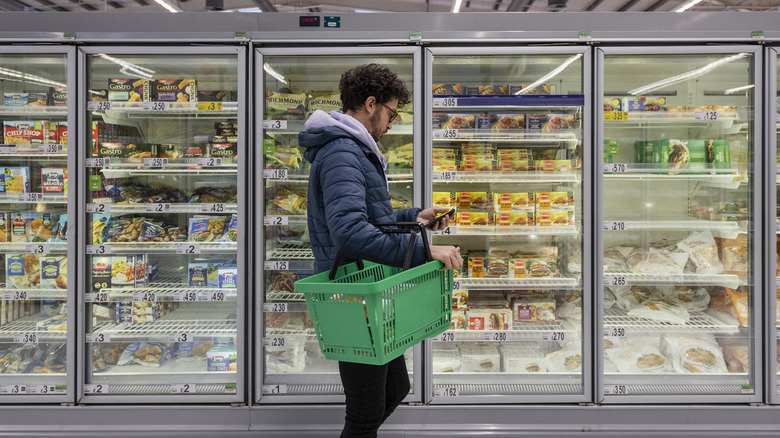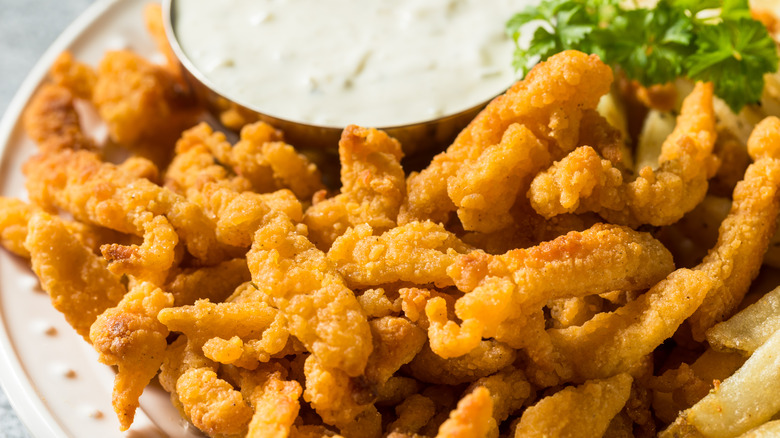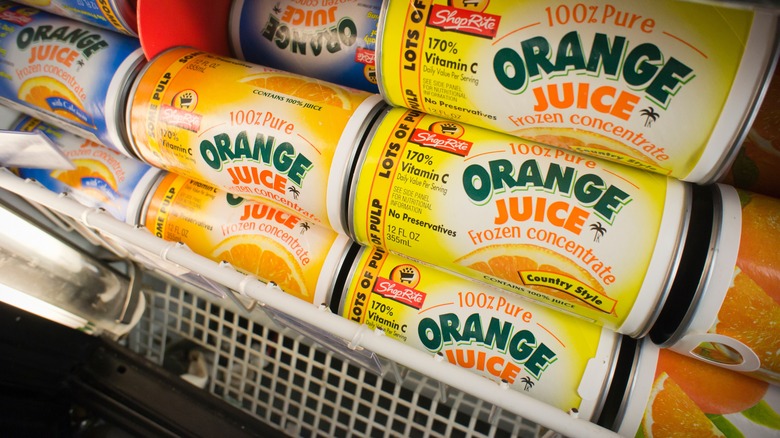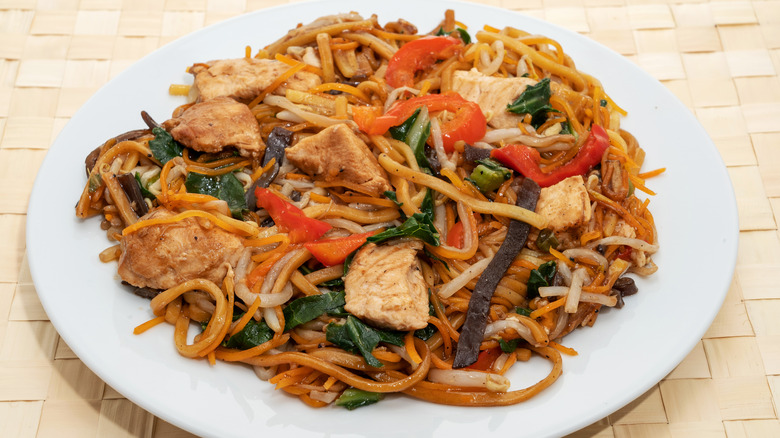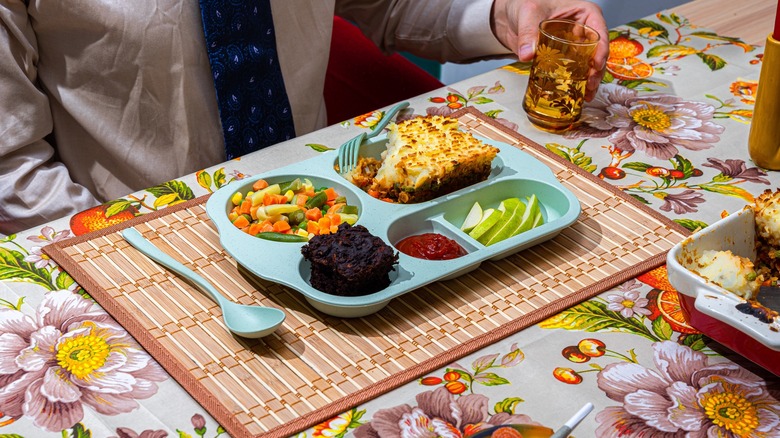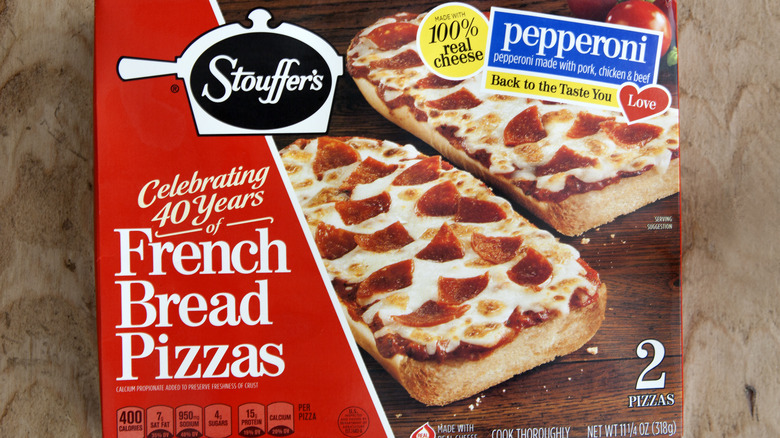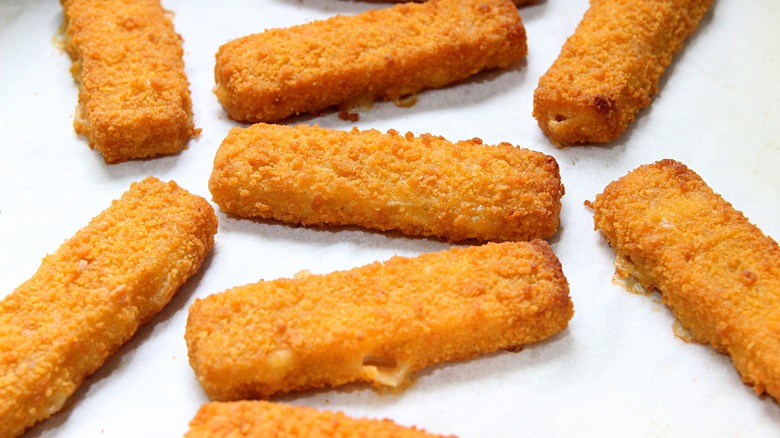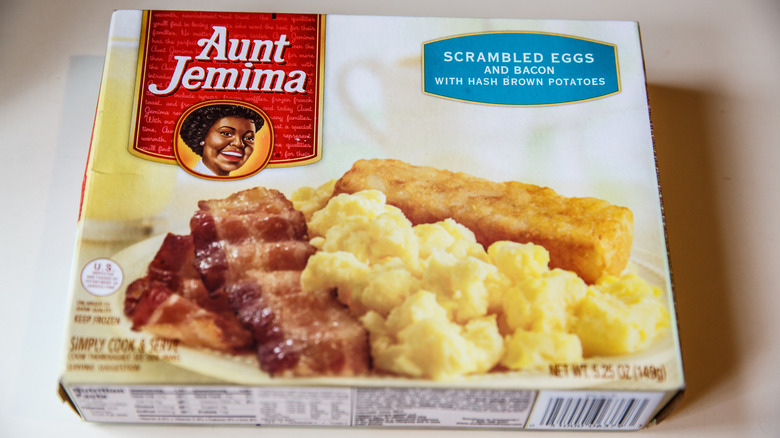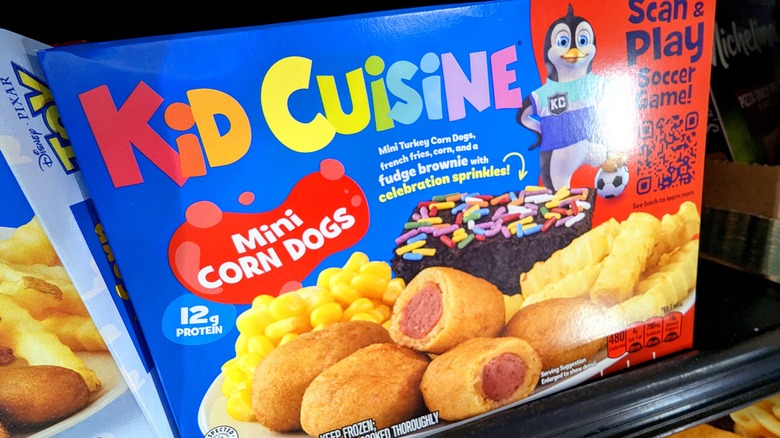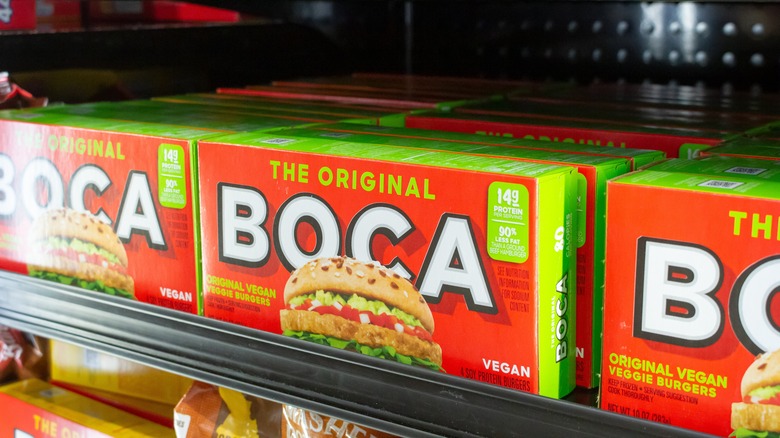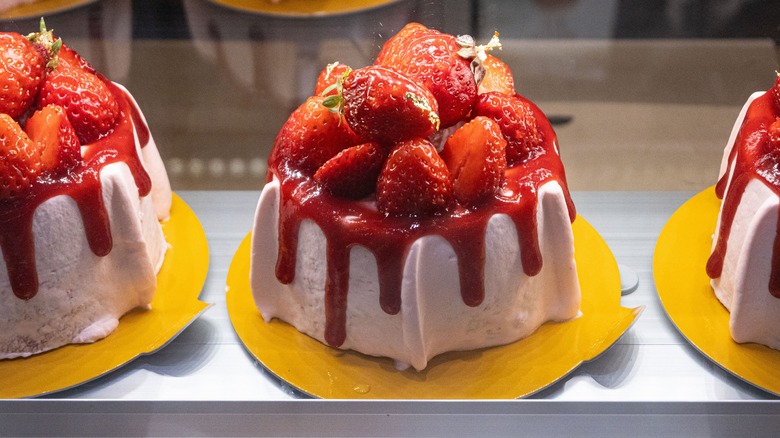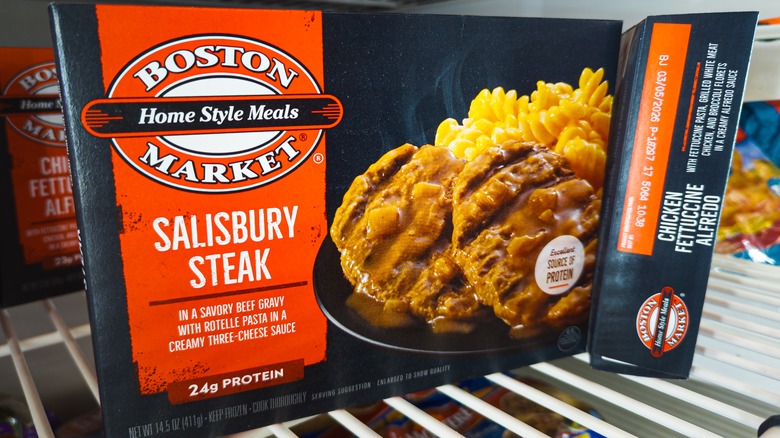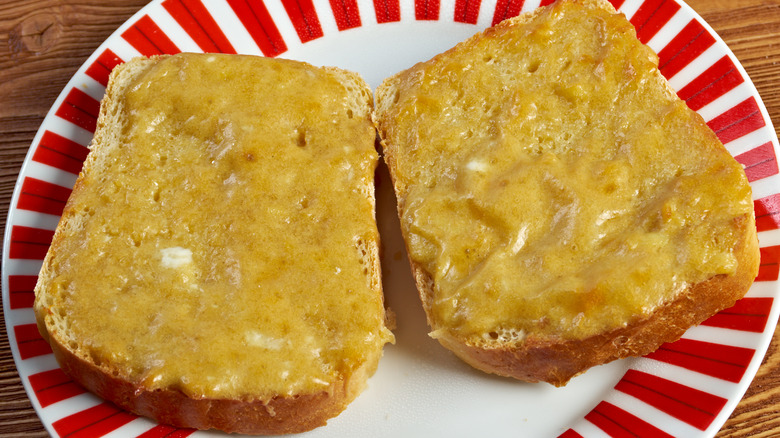Old-School Frozen Foods No One Really Eats Anymore
Frozen food has become such a staple of modern life that it's easy to forget that it's only a little over a hundred years old. And while people have been freezing food to preserve it for thousands of years, it wasn't until 1924, when Clarence Birdseye founded his company, Birdseye Seafoods, that frozen food became commercially available. Birdseye's flash-freezing process changed the way consumers ate and stored their groceries, preserving easily spoiled fruits and vegetables, and ensuring that once-seasonal items were available year-round. But, as you can imagine, everyone's tastes and eating habits have changed a lot in the last hundred years, which means that many once-popular frozen foods are no longer the sought-after treats they used to be.
So, we decided to look back at a few of the icy items that your parents (and grandparents) used to keep in their freezer. Oh, and if you're interested in more information about the history of keeping foods piping cold, we've also put together a brief history of refrigeration, or how mankind will do anything for a cold beer.
Fried clam strips
While you can still find fried clam strips at your local grocery store, you may not be aware of just how popular these breaded mollusks used to be. Fried clams are actually only slightly older than commercially available frozen foods, as they're commonly believed to have been invented in 1916 by a Massachusetts potato chip vendor who tried frying up some unsold clams when his chips weren't selling. Although, there's evidence that restaurants may have been selling other version of fried clams as far back as the 1800s.
Now, that vendor sold whole fried clams, but it was the restaurant chain Howard Johnson's that popularized the "clam strip," which just used the foot of the hard-shelled sea clam. By 1954, there were 400 Howard Johnsons selling those clams across the country, making what started out as a New England treat into a nationally available dish. And since those clams already came to the restaurants frozen, it wasn't long before the company was selling bags of frozen Howard Johnson clam strips in grocery stores.
However, as food trends became healthier in the 1980s, fried clams lost a lot of their popularity, slowly becoming one of those vintage seafood dishes no one eats anymore. As for Howard Johnson's, it reached its peak in 1979, when there were 1,040 locations across the world. However, the chain slowly declined as fast food began to replace the sit-down casual dinner, with the last Howard Johnson's, located in Lake George, NY, closing in 2022.
Frozen orange juice concentrate
When you walk through a grocery store aisle full of bottles and cardboard cartons of orange juice, you might forget that you can also get your orange juice in the freezer section. However, those cartons of ice-covered OJ aren't the oldest way you could buy orange juice. The first commercially available orange juice brands, which first hit shelves in the 1930s, were canned and featured a very different taste from freshly squeezed juice. Those canned brands also weren't very popular, but that changed after some experimentation by the Army during World War II developed a way of freezing orange juice concentrate that preserved a lot (but not all) of the orange flavor, although it still wasn't as good as the fresh stuff. It was that frozen orange concentrate that became a part of the traditional American breakfast, and the preferred way to buy your morning juice.
What changed? In the 1990s, juice companies finally developed a way of preserving fresh orange juice that could be shipped by carton. And while those cannisters of frozen concentrate are still around, they've fallen into the shadow of their bottled brethren, becoming obscure enough to make customers ask, "Whatever happened to frozen orange juice?"
Frozen chow mein
When you're thinking of classic American "Chinese" food, "authentic" isn't a word that immediately comes to mind. In this case, we're talking about chow mein (an Americanization of "chau meing," which means "stir-fried noodles" in the Taishan dialect). This noodle dish was first brought to the States by Chinese immigrants in the 19th century. But over the years, the original dish was slowly transformed by American tastes into the Americanized "chow mein." By the 1950s, American consumers could buy the dish in ready-made frozen form, with the most popular being the Chung King brand, created by Italian American chef Jeno Paulucci, who went on to create Jeno's Pizza Rolls.
But while chow mein remained popular with American buyers for decades, by the time the '80s rolled around those buyers were being exposed to more authentic Chinese cuisine, and American-Chinese dishes like chow mein and chop suey had lost a lot of their popularity. Nowadays, you can find many more authentic frozen Chinese dishes in your local freezer aisle, but it can be much harder to find the "Chinese-inspired" chow mein. If you're curious about the difference between chow mein and lo mein, we can help explain.
TV dinners
It's a classic image of the 1950s: a family gathered around the TV, each eating their own TV dinners on metal trays. The history of the TV dinner can be traced back to one company, Swanson, which was left with too much leftover turkey meat for Thanksgiving in 1953. Looking to make money off the mistake, the company put out a frozen turkey dinner, complete with side dishes and dessert on one easy-to-reheat tray.
That ordering error created the TV dinner, which went on to become a phenomenon, becoming the go-to, easy-to-reheat meal of the decade. However, as frozen technologies and consumer tastes changed, the all-in-one frozen meals gave way to more complex, single-dish meals, which didn't have to balance different cooking times for each part of the meal. (Let's face it, your brownie and applesauce are never going to need the same amount of cooking.)
While you can still buy frozen meals today, the classic TV dinner with different courses served in different compartments has never regained the popularity it had in the '50s. (Although it did see an understandable rise in popularity during the pandemic lockdown.) And if you'd like to learn more about this easily reheatable meal, here are some fun facts about TV dinners.
French bread pizzas
When Stouffers launched the French bread pizza onto the market in 1974, they quickly became a popular snack and meal, partially because the quality of regular frozen pizzas just wasn't that good. (They were often thin and doughy, and definitely didn't deliver on the delights of a freshly-delivered pizza.) On the other hand, French bread pizzas delivered a crisp, crunchy taste with almost every bite, while also balancing plenty of cheese and sauce. As one of the millions of former kids who remembers being delighted when my dad would slap these guys into the oven, I can verify that they were genuinely exciting to eat, even after they became a regular fixture in school lunches.
But while French bread pizzas never got better, frozen pizzas did. Nowadays, you can find whole frozen pizzas that are at least as good as these, while also offering larger portions. That's because, let's face it, pizza is often about getting as much food as possible. And while some of us still get the nostalgic thrill from biting into these doughy bad boys, we also have a ton of other (and often better) pizza options available.
Fish sticks
You may have noticed this list is full of items that used to be easy-to-cook foods that parents could quickly make for their kids. That's definitely true for fish sticks, the breaded cod fillets that filled countless quick and easy home dinners. And while these are definitely still popular (and convenient), they're just not as popular as they used to be in the '50s and '60s, when they were the go-to frozen meal to feed growing kids. In fact, that's how they were marketed by their original manufacturer, Gorton's, which used articles in Parents Magazine to tout fish sticks as a time-saving device for the "harried housewife." It worked, largely because a dish you could cook by just throwing some frozen fish in the oven for 30 minutes or so, really was the height of convenience. And that convenience also made it an easy dish to throw in school lunches.
But these days, there are a lot of even easier-to-cook options out there, possibly because of other easy options, and also because consumers are switching to slightly more nutritious alternatives. (Some companies also started changing their recipes to sound fancier, referring to them as "fillets.") However, they did get a bump in popularity during the pandemic, as quarantine diners sought out easy and cheap foods. And fish sticks definitely qualify as both.
Frozen breakfast platters
These days, most people probably think of frozen breakfasts as something you can grab on the way out the door. You know, the kind of quick, easy food you can wolf down in your car or on a subway platform. But there used to be a large market for full frozen breakfast platters, which offered ready-to-eat full breakfasts, often with eggs, bacon, and potatoes. Think of them as TV dinners, but with eggs.
As for why they aren't as popular now as they used to be, it comes down to a simple question: Who has time to sit down for a full breakfast, anymore? If you're in the market for a quick, frozen breakfast, you probably don't have time to sit down and eat a full breakfast platter. And if you do feel like splurging and treating yourself to a traditional American breakfast, you probably want something that's a little better quality than a reheated plate of slightly rubbery eggs. It's no wonder that today's frozen breakfasts are more focused on convenience, offering the same ingredients of eggs, bacon, and potatoes, but in a handy wrap, sandwich, or burrito form.
Kid Cuisine frozen dinners
As you may have been able to tell from the eye-wateringly bright colors on the box, or from just reading its name, Kid Cuisine was a frozen dinner meal targeted toward children, offering kid-friendly dishes like chicken nuggets or corn dogs along with vegetable sides and desserts. Launched in 1989, these dinners were a popular choice with parents throughout the '90s, offering a quick and easy alternative to other reheated meals and luring in kids with gimmicks like color-changing pudding or "cookie spoons" to eat with dessert.
And while you can still get these kid-targeted frozen dinners today, they're nowhere near as popular as they were in the '90s. It also didn't help that dishes like these were linked to increases in obesity in the 2010s, and parents had also started to move away from some of the gimmick-related kids' foods of the 1990s for more nutritious offerings. Which is a shame, because I could really use a cookie spoon right now.
Boca Burgers
If you're an older vegetarian, you're probably familiar with Boca Burgers, which advertises itself as "the original vegan veggie burgers." This soy protein burger first hit stores in the early 1980s, although the brand didn't get national attention until it was purchased by Kraft, which expanded the line to reach stores across the country. At the time, Boca Burgers were kind of a niche item, appealing only to vegans and vegetarians. But as those numbers grew and others started looking into living a meatless lifestyle, their market increased.
But that increased market also brought a lot of other veggie competitors. And these days, Boca Burgers, while still around and selling, have been largely overshadowed by other, trendier, meat alternatives like Beyond Meat and Impossible Burgers. (And that's not counting the wide range of other veggie patties made of tofu, black bean, quinoa, bread, brown rice, seitan, or cashews, that were inspired by the Boca Burger.) While Boca may have been the original, these days, Bocas are just another kind of veggie patty on a very crowded grocery store shelf.
Frozen strawberries in syrup
Strawberries are a notoriously seasonal fruit, typically ripening between May and June. And so, before the age of frozen foods, you simply couldn't get them at any other time of the year. But once freezing came about, these sweet fruits could be stored and sold year-round. However, they weren't the simple frozen strawberries you see on today's shelves, as they were covered in a sweet syrupy concoction, which protected against freezer burn and preserved the strawberry taste. It also delivered a massive hit of sugar, which made these sweet berries very popular in dishes like strawberry pie.
However, these days, improved freezing technology means that we can enjoy frozen strawberries in their natural, non-syruped form. And international trade allows stores to ship in strawberries from overseas locations like Australia and South Africa, which makes them available year-round. All of which means, if you want your strawberries covered in sugar, you'll just have to do it yourself. (If you do some searching, you'll find tons of syrup recipes to recreate what used to be the only way to buy your berries.)
Salisbury steak
If you come across this dish, which used to be one of the most popular items in TV dinners and school lunches, you may be asking: Is Salisbury steak actually steak or something else entirely? Well, it's actually a seasoned beef patty smothered in gravy. It got its name from its creator, Dr. James Henry Salisbury, who promoted the dish in the 1800s as a cure for digestive troubles. It's easy to cook, and cheap ingredients made the dish really easy to mass-produce, which made it a popular choice for frozen dinners and cafeterias. And it remains a nostalgic favorite for many of us who looked forward to finding it on our school lunch trays.
However, you don't see it on the menu much these days. That's probably due to health concerns, as the recipe tends to call for a large amount of both fat and salt, which are a lot less appealing in these healthier times. (For example, the Banquet Salisbury Steak meal will give you 25% of your daily allowance of saturated fat and 45% of your suggested sodium intake.) Which is ironic, considering its origin as a health food. And while you can still find it in your local freezer aisle, it's nowhere near as popular as it used to be, except in our sodium-filled hearts.
Welsh rarebit
When you're talking about a dish that's pretty much just mustard, melted cheese, and bread, you'd think people would just make it themselves. But this toasty dish was actually a really popular frozen meal, with Stouffers offering a frozen version of this dish starting in 1966, which lasted on store shelves for 55 years. And that's not a bad run for a dish that looks like you made it with the only ingredients in a college kid's fridge. (If you're curious about the name, one theory is that it started out as a poor man's alternative to meat, specifically rabbit. Which would explain why some still refer to it as "Welsh rabbit.")
In 2021, Stouffers announced it was discontinuing production, presumably due to declining sales, which led to some publicity as fans of the dish voiced their displeasure online. These days, you can still find some frozen versions of the dish from other companies, which are often fancier than the original versions with better quality ingredients. But honestly, if you've got a microwave, it's almost easier to make it yourself. And probably faster, too.
